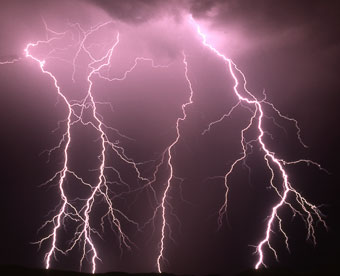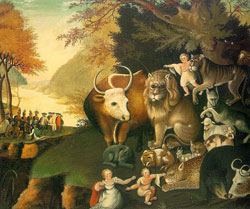 Our desert monsoon has arrived, and the hills are turning from brown to green. The monsoon is a seasonal shift in our southern Arizona weather patterns, bringing moisture-laden air from Mexico to mix with the desert heat, resulting in sometimes-violent thunder storms. These powerful storms are capable of producing flash floods and downing trees, along with very dramatic displays of lightning.
Our desert monsoon has arrived, and the hills are turning from brown to green. The monsoon is a seasonal shift in our southern Arizona weather patterns, bringing moisture-laden air from Mexico to mix with the desert heat, resulting in sometimes-violent thunder storms. These powerful storms are capable of producing flash floods and downing trees, along with very dramatic displays of lightning.
But with all that violence comes precious rain; without these seasonal rains, the desert would perish.
When I was growing up, I was terrified of lightning. I can remember waking up at night during a storm and hiding under the blankets to protect myself. As an adult, I learned to appreciate the beauty and power of a thunder storm and have often gone up to the roof with my camera to photograph lightning strikes. This photo is one of my favorites.
I feel perfectly safe on the roof in a thunder storm; lightning, as we know, prefers to strike trees and golfers, and I am neither. Extensive research has failed to turn up a single instance of lightning ever striking a blogger.
(Full disclosure: I only photograph storms when they are quite distant, using a telephoto lens.)
I think what fascinates me about lighting is the way it combines beauty with violence, two things you wouldn’t instinctively expect to find together. Describing it that way, lightning seems an apt metaphor for life itself. We live out our lives amidst beauty and violence. We both love and hurt those close to us. We strive for peace but scream obscenities at those who stand in our way. We practice compassion and kindness with those we know while ignoring the misery of strangers.
The entire history of humanity has been thus, and though I believe with all of my heart in the importance of building a world that lives at peace, we never seem to get there, do we?
My Christian theology is helpful here. It gives an explanation for our failure to do away with violence and all of its cousins: hatred, injustice, neglect, prejudice, war, etc. The doctrine of sin says that we have these things inside of us, and we can’t hope to eradicate them from society at large until we allow God to transform us individually into something more beautiful than we are.
Isaiah’s prophecy about a future era of peace to be ushered in by the Messiah (Isaiah 11) includes this famous passage, which the Quaker artist Edward Hicks used as the inspiration for his equally famous painting “Peaceable Kingdom”:
In that day the wolf and the lamb will live together; the leopard will lie down with the baby goat. The calf and the yearling will be safe with the lion, and a little child will lead them all. — Isaiah 11:6, NLT
 Despite our past failures, we are not powerless against violence, even in this present age of conflict. And God does not permit us to acquiesce to violence, injustice and the rest, no matter how firmly entrenched they may be in our imperfect society.
Despite our past failures, we are not powerless against violence, even in this present age of conflict. And God does not permit us to acquiesce to violence, injustice and the rest, no matter how firmly entrenched they may be in our imperfect society.
David writes that righteousness and justice are the very foundations of God’s throne. (Psalm 97:2). His point is that we need to model ourselves and our society on such a peaceable kingdom, a point that God makes explicit in Deuteronomy 16:19-20, when he calls Israel to live by principles of justice and warns them never to be guilty of perverting it.
The prophet Amos patiently explained that God prefers that we would live justly and rightly to anything else we might offer him:
I will not accept your burnt offerings and grain offerings. I won’t even notice all your choice peace offerings. Away with your noisy hymns of praise! I will not listen to the music of your harps. Instead, I want to see a mighty flood of justice, an endless river of righteous living. — Amos 5:22-24, NLT
The prophet Micah reiterates this point:
No, O people, the LORD has told you what is good, and this is what He requires of you: to do what is right, to love mercy, and to walk humbly with your God. — Micah 6:8, NLT
Jesus made these principles even more personal. He grew up in a time of unimaginable violence, when Israel was occupied by the Romans, a military dictatorship that has been compared to Nazi Germany for both its unbreakable grip on power and its violent methods of maintaining civil order. As a boy, Jesus would have seen the dead and dying bodies of Jews raised on crosses beside the roads, as well as other examples of Roman cruelty: heavy taxation, confiscation of personal property, abusive practices by bored soldiers, and the constant fear that some small thing would bring swift and terrible reprisals against loved ones.
Yet, in his life and teachings, Jesus was an unabashed pacifist, a deeply disappointing fact to many who hoped he would lead a war against the Roman occupation. A full reading of the New Testament suggests he understood the necessity of acting forcefully against evil, but doing so personally was not part of his mission.
Instead, he emphasized the truth that peace begins within us. If we are to have a society that is at peace, we must ourselves live in peace, acting in compassion and generosity towards the poor, the oppressed, the hurting, the imprisoned, the orphaned. He taught that justice and peace begins with a transformation inside of us, not with better laws or stronger prisons.
It is as if God has painted a beautiful canvas, but it has been stained by violence and blackened by millennia of misery and injustice. Like an art conservationist, Jesus Christ is patiently restoring God’s painting, removing the grime, bringing out the hidden colors. One person at a time. One life at a time.
As he transforms you and me, we will have many opportunities to transform the world we live in. Beauty can overcome violence, and one day the lamb will lay down with the wolf.
Photo credit: Charles Lehardy, 2000. Peaceable Kingdom by Edward Hicks (1780-1849)


Thank you so much for this post. It brought fresh air and new meaning to some old Christian language and expressions from my childhood in which it has been hard for me to continue to find meaning (for example, accepting Jesus into one’s heart). I particularly loved the art conservation imagery, and found that helpful in continuing to follow my sense of vocation and find meaning as a musician-turned-lawyer. “One person, one life at a time” . . .
The pictures are also wonderful; thanks again.
As usual, Charlie, a great post. Thank you for it.
Mark
The lightning reminds me of the trip my family took in 1969 from San Diego to Houston in July to visit relatives. As we drove across the desert, a heat storm raged in the distance, the black rain cloud flat on the bottom and a tube of rain falling from just the center of the cloud. Lightning lashed all around the rain, and “Crystal Blue Persuasion” played on the car radio. I can’t hear that song without the image of the storm coming to mind.
And Jesus wasn’t a complete pacifist. He cleared the temple none-too-peacefully. His anger, though, was on behalf of God, never on His own behalf.
I, too, like the art conservation analogy. Great post.
Marvellous post Charlie. WE are in winter here and have had our hsare of electrical stroms lately. I confess I sometimes still get afraid. Other times I’m awed by the power of them. As one commenter already said you have brought a freshness to this subject. And I hear so much that is bad on the news that I appreciate the reminder of that age of peace to come.
Hi Charlie –
Long time no post. Are you okay?
Susan